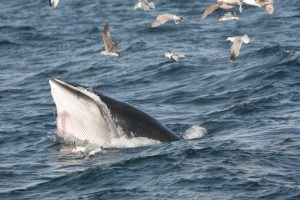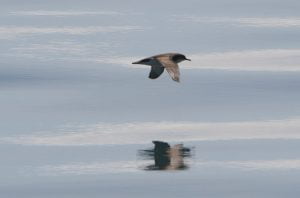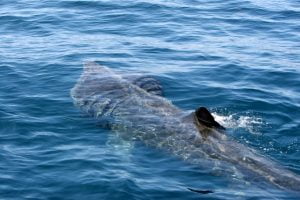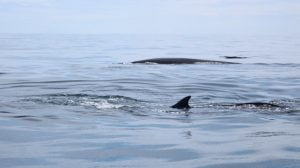It’s always something of a challenge, finding cetaceans out at sea, and would be a lot more difficult without the help of the numerous sea birds in Irish waters. All oceanic birds are wonderful creatures to watch, on the wing, on the water, and most of all, when they are feeding, showing off their amazing fish-catching skills.

When searching for marine mammals, a constant watch is kept for any aggregation of fishing birds. The two species that are the most helpful in locating whale and dolphin activity, without a doubt have to be gannets and Manx shearwaters. Both of these species have extraordinary skills, perfected over millions of years at sea, fishing for a living.
If there was a competition for being the perfect sea bird, my money would go on the gannet. A large, dazzling white bird, with jet black wing tips, and a splash of pale ochre gold on their head and upper neck, close to 6 feet in wingspan, and powerful flying birds that range up to 200 miles from their nesting colonies in search of fish. They take 5 years to become breeding adults, and live to around 35 years.
Unlike most other birds, they have no external nostrils, but have them inside the mouth. They have evolved this feature to facilitate their fishing technique of plunging into the sea at death defying speeds from the air above. They even have air-bags in their face and chest, to lessen the hard impact of hitting water at high speed! They do all their hunting from high in the air, and are capable of staying in the air all day, in search of prey. This makes them a high-energy bird. As in aircraft, it takes a lot of energy to stay in the air all day, they have become very successful predators in doing so. A recent assessment of the population of northern gannets was a million or so. Close to 70% of that number, nest in colonies around the British Isles. Most gannets in West Cork waters are nesting at the Skelligs colony, off the Kerry coast.
When any fish or cetacean activity is detected by them, they close in on it and wheel continuously above any action below, watching for the opportunity to dive in for a beak full of fish. They spend just a few minutes or less in the water, before they’re back in the air.
Gannets have fantastic eyesight; they can see activity up to 6 miles away, activity that we humans would need a good telescope to detect. They watch all other gannets within their visual range, and as soon as 1 or 2 of them commence their wheeling behaviour, all others nearby will start moving in. If the wheeling birds then start diving, all birds in visual contact begin to fly in at speed to join the fray. This becomes a chain reaction as gannets from further and further away respond to the movement. If there is a prolonged spell of fish catching, an enormous cloud of birds will form from far and wide around. Sometimes there can be so many that they take on a blizzard effect where it is hard to see through them. They can also see fish deep in the water column, again these are fish that would be undetectable to us.
If you are at close quarters to a gannet, you cannot miss the striking pale china-blue colour of their eyes, with a very small pupil at centre. How this tiny pupil provides these birds with such incredible vision can only be marveled at. An examination of a gannet’s skull reveals the fact that they have enormous eyes for their size, their head is almost entirely filled by eyes with very little space left for a brain, or much else.
Gannets’ fishing technique gannets is awesome, dropping out of the air in a delta shape to hit the sea surface at high speed, with their wings folded right back along the body, so as to present as good a dart shape as possible, to minimise the impact and gain the depth required to catch their prey. A large cloud of fishing gannets is one of nature’s best spectacles at sea, particularly when they are grabbing fish in bait-balls created common dolphins. The higher in the air they dive from, the deeper the prey is in the water.

We generally think of sea birds as noisy raucous creatures, but both gannets and shearwaters are silent in flight and only make noises at their nest sites, or when diving at fish shoals. Manx shearwaters have a completely different approach to fish finding, they do it by smell, rather than vision. Gannets do all their hunting from high in the air, whilst shearwaters do it from inches above the sea. Their name “shearwater”, is a description of their behaviour, flying as close as possible to the water, shearing the surface, and sniffing for fish under water as they travel. You will rarely see shearwaters more than a few metres above the sea. When prey fish are located, the birds literally fly into the water, from inches above it, grab a beak-full of small fish, and fly out of the water, straight back into the air and are totally dry as soon as they’re airborne.
Their Latin name, Puffinus puffinus, comes from hundreds of years back in history, when fat fledglings were taken from their nest burrows and salt cured for human consumption, along with other fledgling seabirds species, and was known as “puffyn”, and considered to be something of a delicacy. Birds are still harvested in this way to the current day in the Faeroe Islands. Somehow the name puffin became attached to the colourful little character we know by that name to this day, which was also taken and eaten in a similar way.
Back in Irish fishing history, Manx shearwaters were known as “mackerel cocks”, from their feeding behaviour of wheeling around excitedly over areas where mackerel are feeding on sprats or whitebait, the same behaviour as they exhibit over feeding whales, minkes in particular. For hundreds of years of drift net fishing in the north east Atlantic, Manx shearwaters were seen as a reliable guide to the presence of whitebait in the water below them and thus the mackerel in attendance. Before echo sounders were invented, they were the only guide as to where to place nets in the hope of making a worthwhile catch of fish.
For a long time, I was baffled by the manner of them, how they could gather so quickly over a feeding minke whale. As soon as the animal takes interest in a shoal of sprats or whitebait, and starts the process of rounding up a shoal into a frightened huddle, (usually referred to as a bait ball), the Manxies are onto it How were they so quick at anticipating where there was going to be a feed of small fish, provided for them by the whale’s activity?
Finally, on glass calm water with shearwaters, mackerel and minke whales all at work, the answer was clear – the tiny bubbles of air that are released by small fish as they rise up in the water column, trying to evade the predators below them. Shearwaters, with their unbelievable olfactory senses, smell these bubbles!
Nearly all species of bony fish have a bag of air trapped in their body cavity, known as a swim bladder. The function of this is to regulate the buoyancy of a fish such that it does not sink or float, but remains at neutral in the water column. When fish are pushed upward by predators, the air in the swim bladder expands in response to the fall in pressure, and the fish release it in small bubbles, before they become so buoyant that they float to the surface to become instant bird food. If there is a good size shoal rising upwards, the water above often resembles freshly poured champagne.

Manx shearwaters spend all day, every day, on the wing, searching for such activity, flying across the wind-stream, and then upwind when any scent is detected, until the source is found. There are very few birds on the planet that spend from dawn to dusk in flight, every single day, so it would come as no surprise that their migratory travels are legendary, from spending the summer in the north Atlantic, and their winter season in the south Atlantic as far south as Brazil and Argentina.
A Manx shearwater that was leg- ringed as a breeding adult in 1953, was recaptured 50 years later, still breeding, in 2003, which suggests they are some of the oldest birds on earth. This bird will have flown more than a million miles on migration alone, never mind all the cruising about, looking for food, all day every day. Like gannets, they spend only very short periods of time in the water, and most of their lives in the air. Underwater they swim with speed and agility, catching small fish, just like penguins or our own auks, using their folded wings as flippers. What a truly amazing creature they are.
For all the above reasons, watching seabirds is an integral part of any whale watch trip on the Holly Jo. If you don’t understand the seabirds you’ll struggle to find whales. Thanks to the evolutionary pressures over millions of years, they have so many advantages over us, that for now anyway, we’ll defer to their vastly superior optics and design and and simply follow them.
Colin Barnes



2 comments
paul nathanson
Dear Skipper,
When is the best time to watch the whales, please??
One day I dream of coming up to see them!————
Pádraig Whooley
Hi Paul…it’s a hard one to answer as you don’t tell us which species you’d like to see, and our minke, fin and humpbacks all have slightly different temporal distributions along the Cork coast….but we hope this info below is useful and that we’ll see you soon in West Cork to experience some of our world class whale watching with Colin Barnes at Reen Pier.
What you might see and when?
The species we record most frequently during the year are: harbour porpoise, common dolphin, minke whale and fin whale. At any time of year we may have occasional sightings of bottlenose and Risso’s dolphins. Killer whales do use this stretch of coastline, but infrequently. April-July is the best time to see the planet’s second biggest fish, the basking shark, and this can also be a good time for Ireland’s smallest baleen whale, the minke. September to December (sometimes extending into January) is peak period for some of the planet’s largest creatures, namely fin and humpback whales, which may on occasion be seen in good numbers right up to Christmas in West Cork. Spring months are our “low season” and March-April are the quietest time for sightings. In summary, wildlife watching is a bit of a lottery, and whale watching is no different. The biggest influence on what you’ll see on any given trip is not whether it is “high or low” season, as the concept of “seasonality” is a little arbitrary; but of far greater significance is how calm it is on the day of your trip. So based on our experience, we’d be confident that a perfect weather day during low season, would produce better sightings than a poor weather day in high season. But rest assured that if there are whales around, there is no whale watch skipper in Ireland with the reputation Colin Barnes has for finding them.
Comments are closed.